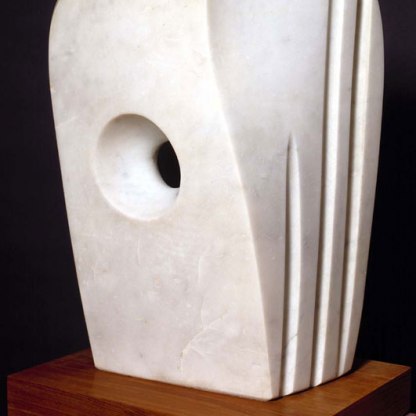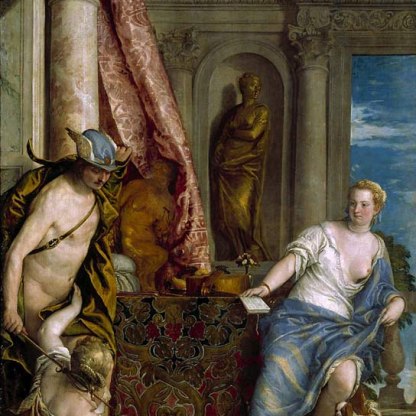Venus Verticordia

The human figure concealed under a frock coat and trousers is not a fit subject for sculpture.
John Gibson
In the figure of Venus, the Roman goddess of love, the sculptor John Gibson found his ideal subject. This work, with its softly modelled face and elegant curves, depicts a paragon of female beauty, a match for the classical statues that the sculptor so ardently admired. And yet Gibson strove to suggest a beauty beyond the physical. In an account of his life, published in 1870, he is quoted as saying,
... the expression I endeavoured to give my Venus was that spiritual elevation of character which results from purity and sweetness, combined with an air of unaffected dignity and grace.
Venus holds an apple, the award bestowed upon her by the shepherd prince Paris for her beauty. It is a fruit often associated in art with carnal love, but Gibson has called his statue Venus Verticordia – 'the turner of men's hearts'. This is not the flighty, promiscuous Aphrodite of Greek myth, but the virtuous, maternal Venus who oversaw the foundation of Rome. The Romans venerated Venus Verticordia on 1 April as a goddess of chastity, as the poet Ovid recounts in his poem about the Roman calendar, Fasti, Book 4, 157–61:
In the time of our ancestors, Rome had lost its sense of shame, so they consulted the venerable Cumaean Sibyl. She ordered a temple to Venus to be built; and, this done, the goddess took the name 'Verticordia'.
At the statue's feet, almost hidden by her drapery, is a turtle upon which the artist has carved a Latin inscription, OPUS IOANNIS GIBSON ROMAE ('the work of John Gibson, Rome'). The animal probably alludes to the goddess' legendary birth from the sea.
Gibson was born in Wales and bought up in Liverpool but lived most of his adult life in Italy, returning to England only twice, in 1844 and 1850, to sculpt portraits of Queen Victoria. In Rome he studied under the great Italian sculptor Antonio Canova and the Dane, Bertel Thorwaldsen, the two foremost neo-classical sculptors in Europe at the beginning of the nineteenth century. In time, Gibson himself became a leading figure among the expatriate artistic community in Rome.
The sculpture in the Fitzwilliam was commissioned by the wealthy British M.P. Joseph Neeld, and was exhibited at the Royal Academy in 1838 before going to Neeld's home, Grittleton House in Wiltshire. It represents the artist's first treatment of a theme that he was to work on over the next two decades, and which culminated in one of the most striking and controversial sculptural works of the nineteenth century: The Tinted Venus. This celebrated statue, now in the Walker Art Gallery in Liverpool, is identical to that in the Fitzwilliam, with one important difference: it is coloured.
When we think of classical sculpture today, we tend to think of it as white. In museums all over the world, Greek and Roman marbles stand on pedestals, clean and monochrome. The colour and texture of the raw marble is in itself often considered integral to the beauty of the works. In the mid-nineteenth century the whiteness of Greek marble was especially admired. Parian porcelain, named after the Greek island of Paros where marble was quarried in ancient times, was developed in the 1840s to imitate the appearance of antique statuary. C.7-1969 is a Parian porcelain version of The Veiled Vestal, a popular nineteenth-century work by the Italian-born sculptor Raffaelle Monti. It is the purest white.
In ancient times, however, statues were painted in bright colours, a fact that was becoming properly appreciated only during Gibson's lifetime. Left is a plaster cast, from the Cambridge University Museum of Classical Archaeology, of a well-known statue dating from c. 530 BCE known as the 'Peplos Kore'. It has been painted to suggest the way that it might originally have looked in the sixth century BCE.
The red lips, golden hair and pale pink flesh of Gibson's tinted Venus caused consternation among visitors to the International Exhibition in London in 1862, where the statue was exhibited alongside other coloured works in a specially constructed 'Greek temple'. The blue eyes seemed to engage the viewer directly, and the statue provoked both extreme embarrassment and intense admiration. Click on the image on the right to tint the Fitzwilliam's statue, and get some idea of the effect.
The first known nude statue of the classical goddess of love was made in the fourth century BCE by the celebrated Greek sculptor Praxiteles. Today this celebrated cult image is known only through Roman copies, but we can get a distant idea of what it looked like from a nineteenth-century cast of one of these in the Cambridge Museum of Classical Archaeology.
So realistic did the original statue look to contemporary viewers, and so intense was its erotic appeal that the story is told of a man who fell in love with it. Hiding in the temple at night, he satisfied his lust upon the image and left a stain upon the marble.
Gibson had a presumably less physically intimate, but comparably obsessive, relationship with his own tinted Venus, and he proved very reluctant to hand over the finished article to the patron who had originally commissioned it, a Mrs Preston. 'It is as difficult for me to part with her', he wrote to her, 'as it would be for Mr Preston to part with you.'
Themes and periods
Data from our collections database
White marble. Venus stands with her head slightly turned to the left, her hair is dressed in Hellenic fashion, and her left knee forward. Over her left wrist is a mantle, and she holds the apple awarded by Paris. On the base, on the viewer's right, there is a tortoise.
Joseph Neeld; Captain L.W. Neeld; Mrs J. Bourne (née Celia Kathleen Mary Neeld); Christie's, 22 September, 1966, Catalogue of The Grittleton Marbles...p. 14, lot 14; sold to Perkins (600 guineas).
Legal notes
Given by the Friends of the Fitzwilliam Museum
Acquisition and important dates
- Method of acquisition: Given
- Dates: 1975-01-30
Dating
Gibson recorded how the wealthy MP Joseph Neeld (1789–1856) had visited his studio in Rome several times before asking him to carve a ‘Venus, nude, but with some drapery modestly arranged without sacrificing too much of the form’. Inspired by Classical prototypes, Gibson showed the Roman goddess of love as an idealised female nude with elegant curves and soft modelling, holding the golden apple, awarded by Paris for her beauty. Although apples are often associated with carnal love, Gibson called his statue 'Venus Verticordia', or ‘the turner of men's hearts’ and later recalled how he had ‘endeavoured to give my Venus that spiritual elevation of character which results from purity and sweetness’. The Romans venerated Venus Verticordia on 1 April as a goddess of chastity. This accounts for the tortoise under her foot: since ancient times, the docile creature who keeps silent and never leaves its house had been a symbol of ‘ideal’ female domesticity. Phidias’ famous lost mid-5th-century BCE ivory and gold statue of Aphrodite at Elis (Greece) rested one foot on a tortoise, and this became a standard way for artists to show the chaste side of the love goddess’ complex character.
This sculpture was exhibited at the Royal Academy in 1839 (no. 1303). Gibson’s composition was so popular that he produced several other versions, including the highly controversial Tinted Venus for the International Exhibition of 1862 (now Walker Art Gallery, Liverpool), which he brightly painted to imitate the original appearance of many ancient statues.
Maker(s)
- Gibson, John Sculptor
- Neeld, Joseph Commissioned
Note
Gibson recorded how the wealthy MP Joseph Neeld (1789–1856) had visited his studio in Rome several times before asking him to carve a ‘Venus, nude, but with some drapery modestly arranged without sacrificing too much of the form’. Inspired by Classical prototypes, Gibson showed the Roman goddess of love as an idealised female nude with elegant curves and soft modelling, holding the golden apple, awarded by Paris for her beauty. Although apples are often associated with carnal love, Gibson called his statue 'Venus Verticordia', or ‘the turner of men's hearts’ and later recalled how he had ‘endeavoured to give my Venus that spiritual elevation of character which results from purity and sweetness’. The Romans venerated Venus Verticordia on 1 April as a goddess of chastity. This accounts for the tortoise under her foot: since ancient times, the docile creature who keeps silent and never leaves its house had been a symbol of ‘ideal’ female domesticity. Phidias’ famous lost mid-5th-century BCE ivory and gold statue of Aphrodite at Elis (Greece) rested one foot on a tortoise, and this became a standard way for artists to show the chaste side of the love goddess’ complex character.
This sculpture was exhibited at the Royal Academy in 1839 (no. 1303). Gibson’s composition was so popular that he produced several other versions, including the highly controversial Tinted Venus for the International Exhibition of 1862 (now Walker Art Gallery, Liverpool), which he brightly painted to imitate the original appearance of many ancient statues.
Place(s) associated
- Rome
Materials used in production
Read more about this record3D scan
Accessibility Notice:
The 3D model on this page is hosted on Sketchfab and may not be fully accessible to everyone, including users of assistive technologies. We apologize for any inconvenience.
Audio description
Other highlight objects you might like
Suggested Curating Cambridge products
Sign up to our emails
Be the first to hear about our news, exhibitions, events and more…





